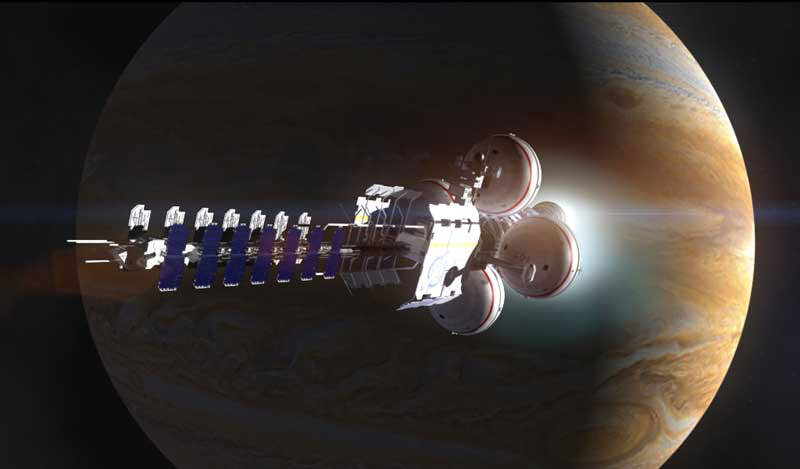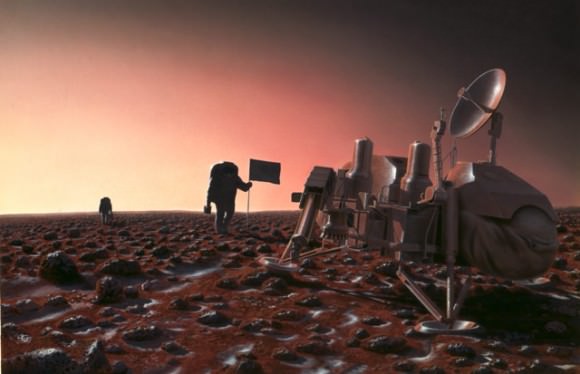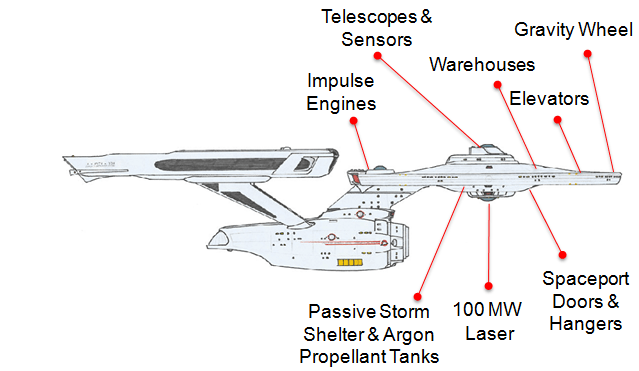It’s time for us to go back and catch up with all of the projects, news stories, weird star systems, and other topics that we need updates on!
Continue reading “Astronomy Cast Ep. 400: State of the Universe”
Should We Go to Mars or Back to the Moon?
When humans finally blast off for another world, where will we be going? Will we return to the Moon, and take over where the Apollo astronauts left off, or will we press onto Mars, and set foot on a whole new planet?
Humanity is going to need to make a difficult choice in the next few years. One that will have implications for the very future of space exploration: classic Star Wars or the new Trilogy? Star Trek fans feel your pain.
But also, we’ll need to figure out whether we should push on with the human exploration of Mars, so that Mark Watney can fulfill his potato destiny, or return to the Moon and build Moonbase Alpha. It’s surprisingly difficult to choose.
First, the case for the Moon. Obviously, the Moon is close. It’s just a few hundred thousand kilometers away, and it only takes astronauts a few days to get there, land on the surface and continue our scientific exploration of this world – which we still know very little about.
Why is the far side so different from the near side? Are there lava tubes and even vast underground caverns that future colonists could live in? It would be great to get more geologist boots on the regolith to find out.
Although it’s expensive, going to the Moon could eventually pay for itself. There are vast reserves of Helium-3 just sitting on the surface of the Moon. This material is rare on Earth, and could be used for future fusion energy planets. Not to mention other valuable minerals and elements that might just be lying around, ready for collection and used for space-based manufacturing.
The Moon makes sense as a testing ground, for humanity to perfect the techniques of surviving and thriving off planet Earth. If we can make it there, then we stand a chance of going the distance as a true interplanetary species.
The big problem with the Moon is that it’s completely inhospitable to human life. There’s no atmosphere, no protection from the Sun’s radiation, enormous temperature variations and a gravity so low it could be lethal over the long term.
The lunar regolith is like tiny shards of glass that would get everywhere, into everything, and be a constant danger to anyone living on the Moon.You couldn’t imagine a worse place to live.
The Moon is close but it sucks, what about Mars? Mars is much much farther than the Moon; the average distance to Mars is about 225 million kilometers.

This means that a journey to Mars with even a short visit to the surface will take the better part of 2 years. Astronauts will be beyond any kind of rescue and completely reliant on their spacecraft and supplies for that entire journey.
During their voyage, they’ll be bombarded with radiation from the Sun and there’ll be no protection on the surface on the planet either, because Mars doesn’t have a global magnetosphere like Earth.
But once they do get to Mars, they’ll have a world that’s much more earthlike. The temperatures are extreme, but can be reasonable at the equator, in the middle of the day. There’s a slight atmosphere, and stronger gravity – maybe your bones won’t waste away if you spend too long there.
To say there’s science to be done on Mars is an understatement. There are so many different terrains, with different geologic features. There’s the outstanding question of whether there was ever life on Mars, and if it’s there now. We’d really like to know the answer.
The Martian regolith is smoother and safer than the lunar version, having been weathered down by wind over millennia. It would still get everywhere, but it wouldn’t give you lung disease.
We now know there are vast reserves of water under the surface of Mars, and astronauts will be able to use this for all kinds of projects, like growing plants, drinking water, breathable atmosphere and even rocket fuel.

Sending humans to Mars is much more complicated and expensive than sending them to the Moon, and the level of space-based infrastructure would be much greater. Assuming we did this right, we’d have much more technology and a stronger presence in space.
Both Mars and the Moon have their pros and cons, but there’s another world that you might want to consider: Venus.
Although Venus is mostly a terrible hellscape, completely worthless down on the surface, where it’s hot enough to melt lead, and the atmospheric pressure is as bad as being a kilometer under the ocean. Did I mention it rains sulphuric acid?
But high up in the cloud tops of Venus, around 50 km altitude, the evil planet becomes downright habitable. You wouldn’t need to wear a spacesuit to regulate the delightful room temperature atmosphere. And you wouldn’t need a pressure suit, because it’s already perfect Earth pressure. You would, however, still need to worry about the sulphuric acid rain. And unless you’ve evolved to breathe carbon dioxide, you’ll need to keep a supply of oxygen handy.
NASA has already proposed sending dirigibles to Venus, filled with our breathable atmosphere for buoyancy, to explore. So maybe the next planet we set foot on, will be the one that we can never set foot on. Hmm, that sounded better in my brain.
You know what, I can’t choose. We should go back to the Moon, we should send humans to Mars, and we should explore Venus too. No matter where we go in the Solar System, it’s going to be an enormous undertaking. We’re going to need to develop new technologies, and risk the lives of everyone involved. But the rewards will be great, moving us one huge leap towards becoming a true interplanetary species.
So now it’s time for you to decide. The fate of humanity rests on your shoulders. Should we press on to Mars, or focus our energy on the Moon or even Venus? Give us your suggestions in the comments below.
The World’s Rockets to Scale
Inspired by a book and poster from 1995, titled “Rockets of the World,” graphic artist Tyler Skrabek has provided a new and updated “clean” look for his latest work.
“The ‘Rockets of the World’ poster emulates a 1960 style of drawing,” he said, “employing a consistent pallet across all rockets allowing for a distraction-free look at the size and power of the world’s greatest machines.”
Skrabek told Universe Today that he’s been working on this poster for 3 months, but he’s had the idea of creating it since 2012.
It is available in various sizes on etsy here.
“The ‘Rockets of the World’ poster is something I put a lot of work into,” he said, “as it’s been my sole project for the last 3 months. Three years ago I was just interested in rockets and wanted to see how the most popular rockets stacked up against each other. But when I looked online to see if I could find a chart, all that existed were height comparisons using technical drawings with 3D renderings of newer rockets squished in. There just weren’t any posters that I could find that used consistent 3D full color renderings and that’s what I set out to create.”
He wanted an uncluttered look for his poster, and therefore used a set of rules to eliminate some rockets: The Rocket had to have more than 3 successful flights and each rocket had to be unique – no later versions from the same rocket family, such as the Soyuz.
Also, rocket wannabes didn’t make the cut … not yet anyway.
“Just to keep things tidy I choose not to include rockets that haven’t flown yet on the off-chance they don’t actually make it off the ground,” Tyler said on reddit. “But rest assured there will be a version that includes the Falcon 9 Heavy as soon as it does.”
A few months ago he created the “Rockets of Human Spaceflight” poster and posted it on reddit. He took suggestions from fellow redditors to create the final version, below. He used that poster as the impetus to continue the Rockets of the World poster.
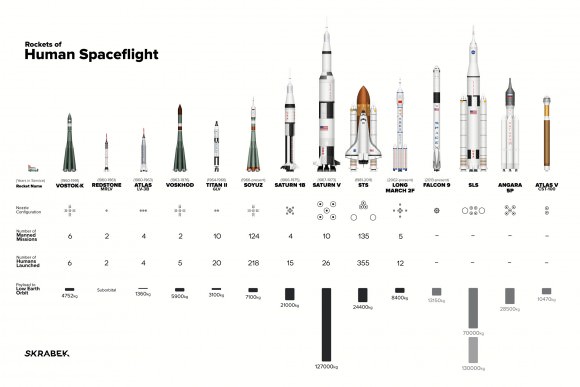
You can see the original “Rockets of the World” illustration from physics professor Peter Alway’s 1995 book “Rockets of the World” here.
Tyler said he’s always been passionate about space, spaceflight and human exploration in space.
“I find it fascinating that we as a society have the power to take a person, put that person inside a metal box on top of a cylinder filled with explosives and explore space,” he says on his website. “As an active member in space circles, I realized there was a lack of infographics that did a reasonable job of portraying comparisons between the various types of spacecraft while being visually appealing. I decided to research and develop a series of infographics to better explain this to the everyday person.”
You can see more of his work on his website here, including his great space infographics here.
On reddit he said, “I hope you like these posters and can help me come up with even more exciting projects!”
Are Intelligent Civilizations Doomed?
One answer to the Fermi Paradox is the idea of the Great Filter; the possibility that something wipes out 100% of intelligent civilizations. That why we’ve never discovered any aliens… they’re all dead. Is that our future too?
In a previous episode, I presented the idea of the Fermi Paradox. If space is huge, like space huge, not aircraft carrier huge, and there are billions upon billions of stars, AND there seem to be lots of habitable planets around those stars, where are all the damn aliens?
Navigating the Solar System Using Pulsars as GPS
Picture the scene: It’s the not too distant future and humanity has started to construct colonies and habitats all across our solar system. We’re gearing up to take that next big step into the unknown – actually leaving the cozy protection of the Sun’s heliosphere and venturing into interstellar space. Before this future can happen, however, there’s an important thing which is often overlooked in discussions on this subject.
Navigation.
Just as sailors once used the stars to navigate the sea, space travelers may be able to use the stars to navigate the solar system. Except that this time, the stars we’d use will be dead ones. A specific class of neutron stars known as pulsars, defined by the repeated pulses of radiation they emit. The trick, according to a recent paper, may be to use pulsars as a form of interplanetary – and possibly even interstellar – GPS.
Theories and ideas on spacecraft engines are plentiful. Foundations such as Icarus Interstellar keenly advocate the development of new propulsion systems, with some systems such as the VASIMR thrusters appearing rather promising. Meanwhile, fusion rockets are expected to be able to take passengers on a round trip from Earth to Mars in just 30 days, and researchers elsewhere are working on real life warp drives, not unlike the ones we all know and love from the movies.
Interplanetary GPS

But navigation is just as important. After all, space is mind-meltingly vast and mostly empty. The prospect of getting lost out in the emptiness is, frankly, terrifying.
To date, this hasn’t really been a problem, particularly seeing as we’ve only sent a small handful of craft past Mars. As a result, we currently use a messy mishmash of techniques to keep track of spacecraft from here on Earth – essentially tracking them with telescopes while relying heavily on their planned trajectory. This is also only as accurate as our instruments here on Earth are, meaning that as a craft gets more distant, our idea of where exactly it is becomes increasingly less accurate.
This is all well and good when we only have a few craft to track, but when space travel becomes more easily attainable and human passengers are involved, routing everything through Earth will start to become more and more difficult. This is particularly the case if we’re planning on leaving the confines of our home star – Voyager 2 is presently over 14 light hours away, meaning that Earth-based transmissions take over half a day to reach it.
Navigating Earth with modern technology is quite simple thanks to the array of GPS satellites we have in orbit around our world. Those satellites are constantly transitting signals which are, in turn, received by the GPS unit you may have on your car dashboard or in your pocket. As with all other electromagnetic transmissions, those signals travel at the speed of light, giving a slight delay between when they were transmitted and when they’re received. By using the signals from 4 or more satellites and timing those delays, a GPS unit can pinpoint your location on the surface of Earth with remarkable accuracy.

The pulsar navigation system proposed by Werner Becker, Mike Bernhardt, and Axel Jessner at the Max Planck Institute, works in a very similar way, using the pulses emitted by pulsars. By knowing the initial position and velocity of your spacecraft, recording those pulses, and treating the Sun as a fixed reference point, you can calculate your exact location inside the solar system.
Considering the Sun to be fixed this way is technically referred to as an inertial reference frame, and if you compensate for the motion of the Sun through our galaxy, the system still works perfectly well when leaving the Solar system! All you need is to keep track of a minimum of 3 pulsars (ideally 10, for the most accurate results), and you can pinpoint your location with surprising accuracy!
Interestingly enough, the idea of using pulsars as navigation beacons dates all the way back to 1974, notably not long after Carl Sagan had used pulsars to show Earth’s location on the plaques attached to the Pioneer 10 and 11 space probes. If Project Daedalus had ever been constructed, it might have been equipped with a system not unlike the one described here.
Packing for long haul
Becker and his colleagues looked at the different types of pulsar visible in the sky, and picked out a type known as rotation-powered pulsars as the best type to use for a galactic positioning system. In particular, a sub-type of these known as millisecond pulsars are ideal. Being older than most pulsars they have weak magnetic fields, meaning they take a long time to slow down their spin rates – helpful as strongly magnetised pulsars can sometimes change their rotation speed without warning.

With countless pulsars to choose from, the question turns to how you might equip your spacecraft to track them. Pulsars are easiest to spot in either x-rays or radio waves, so there’s a little choice as to which may be better to use. Essentially, it all turns out to be a question of how large your spacecraft is.
Smaller vehicles, more akin to modern spacecraft, would be best off using x-rays to track pulsars. X-ray mirrors, like the ones used in certain orbiting space telescopes are compact and lightweight, meaning that a few could be added for a navigation system without increasing the overall mass of the craft all that much. They may have the minor disadvantage that they may be easily damaged by an x-ray source which is too bright, this wouldn’t be a problem except under some unfortunate circumstances.
On the other hand, if you’re piloting a large space ship between planets or even stars, you would likely be better using radio waves. In radio frequencies, we know a lot more about the way in which pulsars work, as well as being able to measure them with a higher degree of accuracy. The only drawback there is that the radio telescopes you’d need to install on your ship would require an area of at least 150 m². But then, if you happened to be flying a starship, that kind of size probably wouldn’t make much difference.
It’s interesting to bear in mind the way that astronomers frequently use the analogy of pulsars being “like lighthouses” when explaining why they appear to pulse. If we someday find ourselves using them as actual navigation aids, that analogy may take on a whole new meaning!
You can read the team’s paper here.
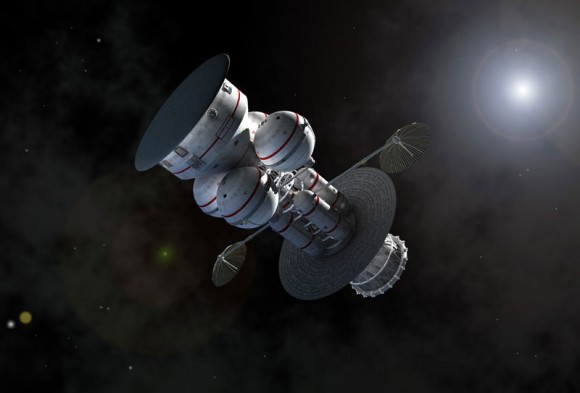
Images are used here with kind permission from Adrian Mann of Icarus Interstellar, whose full gallery is viewable online at bisbos.com
Spacetime Fabric Softener: An Animation to Make You Smile
I’ll just leave this here. Happy Friday!
(ht to io9)
New Study Shows Cosmic Rays Could Cause Alzheimer’s
Humans explore Mars in “Distant Shores,” an illustration by NASA artist Pat Rawlins
Cosmic rays from deep space could pose serious health risks to future astronauts on long-duration missions to Mars — even bringing on the memory-destroying symptoms of Alzheimer’s disease, according to the results of a new study from the University of Rochester Medical Center.
While NASA has its sights set on the human exploration of Mars within the next several decades, even with the best propulsion technology currently available such a mission would take about three years. Within that time, crew members would be constantly exposed to large amounts of radiation that we are protected from here by Earth’s magnetic field and atmosphere. Some of this radiation comes in the form of protons from the Sun and can be blocked by adequate spacecraft shielding materials, but a much bigger danger comes from heavy high-energy particles that are constantly whipping across the galaxy, shot out of the hearts of exploding giant stars.
“Because iron particles pack a bigger wallop it is extremely difficult from an engineering perspective to effectively shield against them. One would have to essentially wrap a spacecraft in a six-foot block of lead or concrete.”
– M. Kerry O’Banion, M.D., Ph.D.
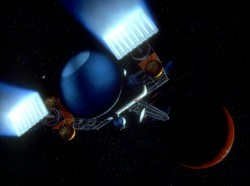 While health risks from these high-mass, high-charged (HZE) particles have long been known, the exact nature of the damages they can cause to human physiology is still being researched — even more so now that Mars and asteroid exploration is on NASA’s short list.
While health risks from these high-mass, high-charged (HZE) particles have long been known, the exact nature of the damages they can cause to human physiology is still being researched — even more so now that Mars and asteroid exploration is on NASA’s short list.
Now, a team from the University of Rochester Medical Center (URMC) in New York has announced the results of their research linking high-energy radiation — just like what would be encountered during a trip to Mars — to the degeneration of brain function, and possibly even the onset of Alzheimer’s disease.
“Galactic cosmic radiation poses a significant threat to future astronauts,” said M. Kerry O’Banion, M.D., Ph.D., a professor in the University of Rochester Medical Center (URMC) Department of Neurobiology and Anatomy and the senior author of the study. “The possibility that radiation exposure in space may give rise to health problems such as cancer has long been recognized. However, this study shows for the first time that exposure to radiation levels equivalent to a mission to Mars could produce cognitive problems and speed up changes in the brain that are associated with Alzheimer’s disease.”
In particular the team focused on iron ions, which are blasted into space by supernovae and are massive enough to punch through a spacecraft’s protective shielding.
“Because iron particles pack a bigger wallop it is extremely difficult from an engineering perspective to effectively shield against them,” O’Banion said. “One would have to essentially wrap a spacecraft in a six-foot block of lead or concrete.”
 By exposing lab mice to increasing levels of radiation and measuring their cognitive ability the researchers were able to determine the neurologically destructive nature of high-energy particles, which caused the animals to more readily fail cognitive tasks. In addition the exposed mice developed accumulations of a protein plaque within their brains, beta amyloid, the spread of which is associated with Alzheimer’s disease in humans.
By exposing lab mice to increasing levels of radiation and measuring their cognitive ability the researchers were able to determine the neurologically destructive nature of high-energy particles, which caused the animals to more readily fail cognitive tasks. In addition the exposed mice developed accumulations of a protein plaque within their brains, beta amyloid, the spread of which is associated with Alzheimer’s disease in humans.
“These findings clearly suggest that exposure to radiation in space has the potential to accelerate the development of Alzheimer’s disease,” said O’Banion. “This is yet another factor that NASA, which is clearly concerned about the health risks to its astronauts, will need to take into account as it plans future missions.”
Read more: Space Travel is Bad For Your Eyes
While Mars explorers could potentially protect themselves from cosmic radiation by setting up bases in caves, empty lava tubes or beneath rocky ledges, which would offer the sort of physical shielding necessary to stop dangerous HZE particles, that would obviously present a new set of challenges to astronauts working in an already alien environment. And there’s always the trip there (and back again) during which time a crew would be very much exposed.
While this won’t — and shouldn’t — prevent a Mars mission from eventually taking place, it does add yet another element of danger that will need to be factored in and either dealt with from both health and engineering standpoints… or accepted as an unavoidable risk by all involved, including the public.
How much risk will be considered acceptable for the human exploration of Mars — and beyond? (NASA/Pat Rawlings)
Read more on the URMC news page here, and see the full experiment report here.
Illustrations for NASA by Pat Rawlings. See more of Rawling’s artwork here. Inset image: comparison of human brains without and with Alzheimer’s. Source: WHYY.
Engineer Thinks We Could Build a Real Starship Enterprise in 20 Years
[/caption]
In Star Trek lore, the first Constitution Class Starship Enterprise will be built by the year 2245. But today, an engineer has proposed — and outlined in meticulous detail – building a full-sized, ion-powered version of the Enterprise complete with 1G of gravity on board, and says it could be done with current technology, within 20 years. “We have the technological reach to build the first generation of the spaceship known as the USS Enterprise – so let’s do it,” writes the curator of the Build The Enterprise website, who goes by the name of BTE Dan.
This “Gen1” Enterprise could get to Mars in ninety days, to the Moon in three, and “could hop from planet to planet dropping off robotic probes of all sorts en masse – rovers, special-built planes, and satellites.”
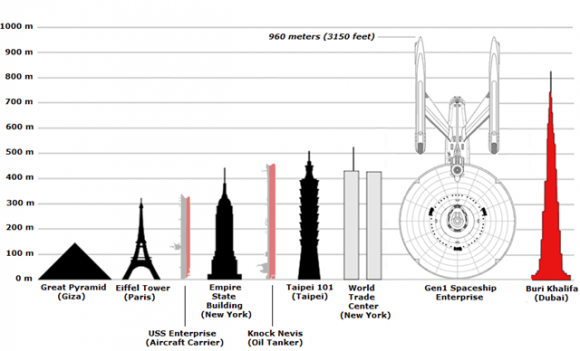
Complete with conceptual designs, ship specs, a funding schedule, and almost every other imaginable detail, the BTE website was launched just this week and covers almost every aspect of how the project could be done. This Enterprise would be built entirely in space, have a rotating gravity section inside of the saucer, and be similar in size with the same look as the USS Enterprise that we know from Star Trek.
“It ends up that this ship configuration is quite functional,” writes BTE Dan, even though his design moves a few parts around for better performance with today’s technology. This version of the Enterprise would be three things in one: a spaceship, a space station, and a spaceport. A thousand people can be on board at once – either as crew members or as adventurous visitors.
While the ship will not travel at warp speed, with an ion propulsion engine powered by a 1.5GW nuclear reactor, it can travel at a constant acceleration so that the ship can easily get to key points of interest in our solar system. Three additional nuclear reactors would create all of the electricity needed for operation of the ship.
The saucer section would be a .3 mile (536 meter) diameter rotating, magnetically-suspended gravity wheel that would create 1G of gravity.
The first assignments for the Enterprise would have the ship serving as a space station and space port, but then go on to missions to the Moon, Mars, Venus, various asteroids and even Europa, where the ships’ laser would be used not for combat but for cutting through the moon’s icy crust to enable a probe to descend to the ocean below.
Of course, like all space ships today, the big “if” for such an ambitious effort would be getting Congress to provide NASA the funding to do a huge 20-year project. But BTE Dan has that all worked out, and between tax increases and spreading out budget cuts to areas like defense, health and human services, housing and urban development, education and energy, the cuts to areas of discretionary spending are not large, and the tax increases could be small. “These changes to spending and taxes will not sink the republic,” says the website. “In fact, these will barely be noticed. It’s amazing that a program as fantastic as the building a fleet of USS Enterprise spaceships can be done with so little impact.”
“The only obstacles to us doing it are the limitations we place on our collective imagination,” BTE Dan adds, and his proposal says that NASA will still receive funding for the science, astronomy and robotic missions it currently undertakes.
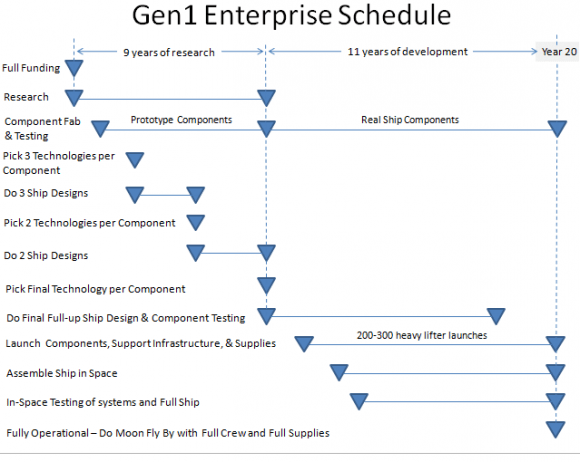
But he proposes not just one Enterprise-class ship, but multiple ships, one of which can be built every 33 years – once per generation – giving three new ships per century. “Each will be more advanced than the prior one. Older ships can be continually upgraded over several generations until they are eventually decommissioned.”
BTE Dan, who did not respond to emails, lists himself as a systems engineer and electrical engineer who has worked at a Fortune 500 company for the past 30 years.
The website includes a blog, a forum and a Q&A section, where BTE Dan answers the question, “What if someone can prove that building the Gen1 Enterprise is beyond our technological reach?”
Answer: “If someone can convince me that it is not technically possible (ignoring political and funding issues), then I will state on the BuildTheEnterprise site that I have been found to be wrong. In that case, building the first Enterprise will have to wait for, say, another half century. But I don’t think that anyone will be able to convince me it can’t be done. My position is that we can – and should – immediately start working on it.”
For the complete space nerd experience, check out Build The Enterprise.
Hat tip to Rand Simberg.
Building an Antimatter Spaceship
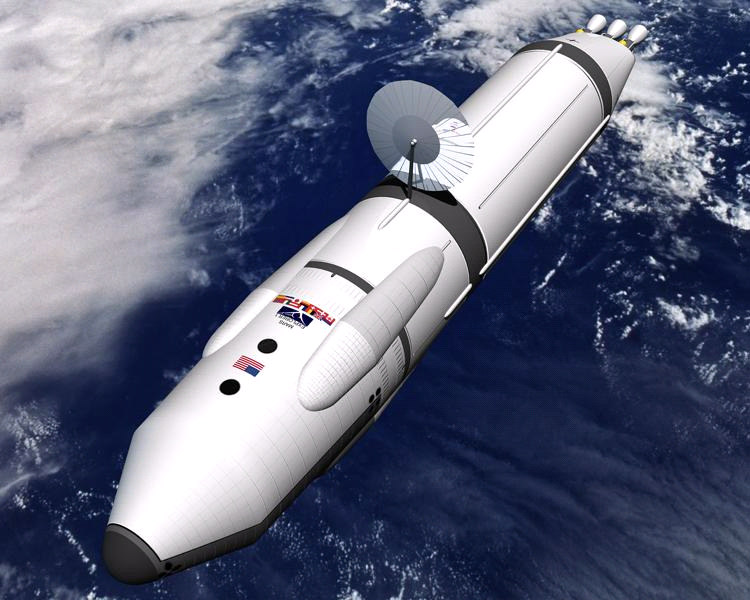
If you’re looking to build a powerful spaceship, nothing’s better than antimatter. It’s lightweight, extremely powerful and could generate tremendous velocity. However, it’s enormously expensive to create, volatile, and releases torrents of destructive gamma rays. NASA’s Institute for Advanced Concepts is funding a team of researchers to try and design an antimatter-powered spacecraft that could avoid some of those problems.
Most self-respecting starships in science fiction stories use anti matter as fuel for a good reason – it’s the most potent fuel known. While tons of chemical fuel are needed to propel a human mission to Mars, just tens of milligrams of antimatter will do (a milligram is about one-thousandth the weight of a piece of the original M&M candy).
However, in reality this power comes with a price. Some antimatter reactions produce blasts of high energy gamma rays. Gamma rays are like X-rays on steroids. They penetrate matter and break apart molecules in cells, so they are not healthy to be around. High-energy gamma rays can also make the engines radioactive by fragmenting atoms of the engine material.
The NASA Institute for Advanced Concepts (NIAC) is funding a team of researchers working on a new design for an antimatter-powered spaceship that avoids this nasty side effect by producing gamma rays with much lower energy.
Antimatter is sometimes called the mirror image of normal matter because while it looks just like ordinary matter, some properties are reversed. For example, normal electrons, the familiar particles that carry electric current in everything from cell phones to plasma TVs, have a negative electric charge. Anti-electrons have a positive charge, so scientists dubbed them “positrons”.
When antimatter meets matter, both annihilate in a flash of energy. This complete conversion to energy is what makes antimatter so powerful. Even the nuclear reactions that power atomic bombs come in a distant second, with only about three percent of their mass converted to energy.
Previous antimatter-powered spaceship designs employed antiprotons, which produce high-energy gamma rays when they annihilate. The new design will use positrons, which make gamma rays with about 400 times less energy.
The NIAC research is a preliminary study to see if the idea is feasible. If it looks promising, and funds are available to successfully develop the technology, a positron-powered spaceship would have a couple advantages over the existing plans for a human mission to Mars, called the Mars Reference Mission.
“The most significant advantage is more safety,” said Dr. Gerald Smith of Positronics Research, LLC, in Santa Fe, New Mexico. The current Reference Mission calls for a nuclear reactor to propel the spaceship to Mars. This is desirable because nuclear propulsion reduces travel time to Mars, increasing safety for the crew by reducing their exposure to cosmic rays. Also, a chemically-powered spacecraft weighs much more and costs a lot more to launch. The reactor also provides ample power for the three-year mission. But nuclear reactors are complex, so more things could potentially go wrong during the mission. “However, the positron reactor offers the same advantages but is relatively simple,” said Smith, lead researcher for the NIAC study.
Also, nuclear reactors are radioactive even after their fuel is used up. After the ship arrives at Mars, Reference Mission plans are to direct the reactor into an orbit that will not encounter Earth for at least a million years, when the residual radiation will be reduced to safe levels. However, there is no leftover radiation in a positron reactor after the fuel is used up, so there is no safety concern if the spent positron reactor should accidentally re-enter Earth’s atmosphere, according to the team.
It will be safer to launch as well. If a rocket carrying a nuclear reactor explodes, it could release radioactive particles into the atmosphere. “Our positron spacecraft would release a flash of gamma-rays if it exploded, but the gamma rays would be gone in an instant. There would be no radioactive particles to drift on the wind. The flash would also be confined to a relatively small area. The danger zone would be about a kilometer (about a half-mile) around the spacecraft. An ordinary large chemically-powered rocket has a danger zone of about the same size, due to the big fireball that would result from its explosion,” said Smith.
Another significant advantage is speed. The Reference Mission spacecraft would take astronauts to Mars in about 180 days. “Our advanced designs, like the gas core and the ablative engine concepts, could take astronauts to Mars in half that time, and perhaps even in as little as 45 days,” said Kirby Meyer, an engineer with Positronics Research on the study.
Advanced engines do this by running hot, which increases their efficiency or “specific impulse” (Isp). Isp is the “miles per gallon” of rocketry: the higher the Isp, the faster you can go before you use up your fuel supply. The best chemical rockets, like NASA’s Space Shuttle main engine, max out at around 450 seconds, which means a pound of fuel will produce a pound of thrust for 450 seconds. A nuclear or positron reactor can make over 900 seconds. The ablative engine, which slowly vaporizes itself to produce thrust, could go as high as 5,000 seconds.
One technical challenge to making a positron spacecraft a reality is the cost to produce the positrons. Because of its spectacular effect on normal matter, there is not a lot of antimatter sitting around. In space, it is created in collisions of high-speed particles called cosmic rays. On Earth, it has to be created in particle accelerators, immense machines that smash atoms together. The machines are normally used to discover how the universe works on a deep, fundamental level, but they can be harnessed as antimatter factories.
“A rough estimate to produce the 10 milligrams of positrons needed for a human Mars mission is about 250 million dollars using technology that is currently under development,” said Smith. This cost might seem high, but it has to be considered against the extra cost to launch a heavier chemical rocket (current launch costs are about $10,000 per pound) or the cost to fuel and make safe a nuclear reactor. “Based on the experience with nuclear technology, it seems reasonable to expect positron production cost to go down with more research,” added Smith.
Another challenge is storing enough positrons in a small space. Because they annihilate normal matter, you can’t just stuff them in a bottle. Instead, they have to be contained with electric and magnetic fields. “We feel confident that with a dedicated research and development program, these challenges can be overcome,” said Smith.
If this is so, perhaps the first humans to reach Mars will arrive in spaceships powered by the same source that fired starships across the universes of our science fiction dreams.
Original Source: NASA News Release




